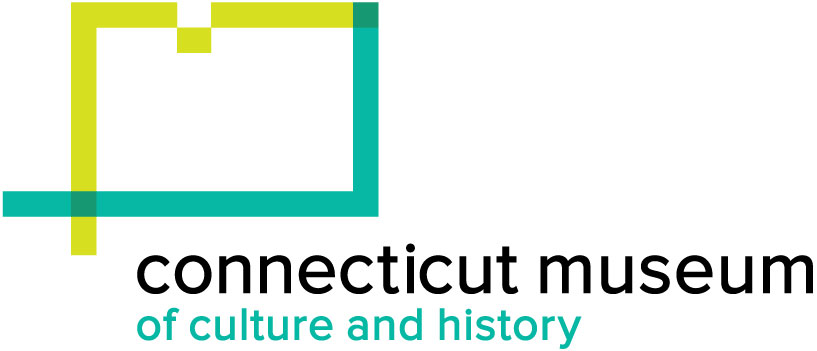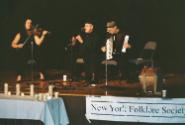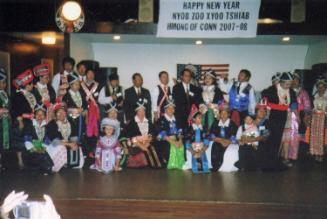Hmong New Year, 2007 and New York Folklore Society Conference
SubjectPortrait of
Heu Lee
(Hmong)
SubjectPortrait of
Boua Tong Xiong
(Hmong)
SubjectPortrait of
Sar Phouthasack
(Laotian)
SubjectPortrait of
Chia Thao
(Hmong)
SubjectPortrait of
Mai Sia Thao
(Hmong)
SubjectPortrait of
Michael Alpert
SubjectPortrait of
Ellen McHale
SubjectPortrait of
Jean Crandall
SubjectPortrait of
Eileen Condon
Date2007 November 17
Mediumborn digital photography
ClassificationsGraphics
Credit LineConnecticut Cultural Heritage Arts Program collections
CopyrightIn Copyright
Object number2015.196.439.1-.32
Description2015.196.439.1-.17 are images from the 2007 Hmong New Year celebration. CCHAP brought a group of visitors to the New Year celebration as part of the Cultural Tourism Bus Tour project.
(.1-.3) Images showing young women in traditional dress performing in the culture show at the 2007 Hmong New Year celebration.
(.4) Image showing participants in the CCHAP bus tour meeting Hmong textile artists at the 2007 Hmong New Year celebration.
(.5) Image showing Hmong leaders onstage at the 2007 Hmong New Year celebration. Pictured left to right are: Mrs. Heu Lee, Heu Lee, Boua Tong Xiong, and Sar Phouthasack.
(.6) Image showing participants in the CCHAP bus tour meeting Hmong textile artists at the 2007 Hmong New Year celebration.
(.7-.8) Images showing young women in traditional dress performing in the culture show at the 2007 Hmong New Year celebration.
(.9) Image showing participants in the CCHAP bus tour meeting Hmong textile artists at the 2007 Hmong New Year celebration.
(.10) Image showing young women in traditional dress at the 2007 Hmong New Year celebration.
(.11-.13) Images showing Hmong leaders speaking to the participants from the CCHAP bus tour at Hmong New Year 2007.
(.14) Image showing women in traditional dress at the 2007 Hmong New Year celebration. Chia Thao Lor is in the center.
(.15-.16) Images showing a group photo of Hmong in traditional dress at Hmong New Year 2007.
(.17) Image showing young women in traditional dress at the 2007 Hmong New Year celebration.
2015.196.439.18-.32 are images showing people at the New York Folklore Society Conference in 2007.
(.18-.19) Images showing social dancing to participating musicians.
(.20-.23) Images showing a jam session onstage featuring Jewish and Mohawk musicians. Jewish musician Michael Alpert is pictured in (.22-.23).
(.24-.27) Images showing social dancing to participating musicians.
(.28-.29) Images showing a jam session onstage featuring Jewish and Mohawk musicians. Jewish musician Michael Alpert is pictured.
(.30) Image showing conference organizers. Pictured left to right are: unidentified person, Kantham Chatlapalli, Ellen McHale, Jean Crandall, and Eileen Condon.
(.31-.32) Images showing conference participants dancing to the music of Sonando.
NotesSubject Note for 2015.196.439.1-.17: CCHAP documented Hmong New Year many times, as part of fieldwork with this community. In November 2007, the event was held at the Elks Club in Enfield, Connecticut.(.1-.3) Images showing young women in traditional dress performing in the culture show at the 2007 Hmong New Year celebration.
(.4) Image showing participants in the CCHAP bus tour meeting Hmong textile artists at the 2007 Hmong New Year celebration.
(.5) Image showing Hmong leaders onstage at the 2007 Hmong New Year celebration. Pictured left to right are: Mrs. Heu Lee, Heu Lee, Boua Tong Xiong, and Sar Phouthasack.
(.6) Image showing participants in the CCHAP bus tour meeting Hmong textile artists at the 2007 Hmong New Year celebration.
(.7-.8) Images showing young women in traditional dress performing in the culture show at the 2007 Hmong New Year celebration.
(.9) Image showing participants in the CCHAP bus tour meeting Hmong textile artists at the 2007 Hmong New Year celebration.
(.10) Image showing young women in traditional dress at the 2007 Hmong New Year celebration.
(.11-.13) Images showing Hmong leaders speaking to the participants from the CCHAP bus tour at Hmong New Year 2007.
(.14) Image showing women in traditional dress at the 2007 Hmong New Year celebration. Chia Thao Lor is in the center.
(.15-.16) Images showing a group photo of Hmong in traditional dress at Hmong New Year 2007.
(.17) Image showing young women in traditional dress at the 2007 Hmong New Year celebration.
2015.196.439.18-.32 are images showing people at the New York Folklore Society Conference in 2007.
(.18-.19) Images showing social dancing to participating musicians.
(.20-.23) Images showing a jam session onstage featuring Jewish and Mohawk musicians. Jewish musician Michael Alpert is pictured in (.22-.23).
(.24-.27) Images showing social dancing to participating musicians.
(.28-.29) Images showing a jam session onstage featuring Jewish and Mohawk musicians. Jewish musician Michael Alpert is pictured.
(.30) Image showing conference organizers. Pictured left to right are: unidentified person, Kantham Chatlapalli, Ellen McHale, Jean Crandall, and Eileen Condon.
(.31-.32) Images showing conference participants dancing to the music of Sonando.
Subject Note: The Hmong community in Connecticut, around 300 in number, is based mostly in the Enfield and Manchester areas. They work in factories and service occupations, as well as skilled manufacturing, often in aerospace industries. The Hmong came to the United States as refugees from the Indochina wars in the 1970s after the Communist takeover of Laos, sponsored by the American government because many Hmong assisted the military and the CIA. At that time the Hmong were persecuted in Laos, and this still continues today with considerable fighting going on. The Hmong are a tribal group originally from Mongolia who migrated to Laos where many still live today. There are also Hmong communities in northern Burma, Vietnam, Thailand, and China (where they are called Miao).
Connecticut Hmong people are both traditional and contemporary. Older women used to make the gorgeous applique and embroidery work known as paj ndau, and they still create traditional costumes for women and men, albeit with modern shortcuts (traditional dyeing techniques are replaced by printed cloth, for instance). Men who are traditional community leaders, such as Boua Tong Xiong, still perform wedding and funeral rituals, as well as conflict resolution according to time-honored practices. Hmong traditions practiced in Connecticut include embroidery and story cloths, funeral and wedding songs, music on the bamboo instrument qeej, ballads and courtship songs kwv ntxhiaj, and social dancing. Hmong leaders started the Hmong Foundation of Connecticut as a way to keep the community together and continue to provide many kinds of needed assistance. The Foundation, which is led by a Board of Directors, is open to all Hmong living in the state. Members provide services such as translation, transportation, family relocation to Connecticut, assistance with finding jobs and access to health care, Hmong language classes, and traditional Hmong advising and dispute resolution. The Hmong Foundation of Connecticut became a separate organization in 1996 after the Connecticut Federation of Refugee Assistance Agencies, an umbrella service group, disbanded. The group sponsors Hmong New Year in November and a celebration for Hmong high school graduates in June.
The Hmong have a number of sub-cultural groups; one of the distinguishing characteristics of the Blue Hmong is their custom of batiking cloth with blue indigo. One specific kind of textile that the Hmong have become known for are the “story cloths”. These are a comparatively new genre first made in the Thai refugee camps around 1975. In these embroidered pieces, direct figurative references are made to folk tales, myths, personal family stories, and scenes of village life. These story cloths also depict the turbulence and hardships of the war years in Southeast Asia. Hmong textile works also include many references to the natural world, to the plants and animals, which are native to the hills of Laos. (Winifred Lambrecht, Ph.D (CCHAP project partner); July 2006)
Subject Note: Hmong New Year, Nyob Zoo Xyoo Tshiab, is the Hmong community’s most important annual festival. The New Year festival, always held late in the year, includes the ball toss, a game between young people that is a courtship ritual; a fashion show of different tribal costumes; a cultural presentation of dance and song; and a community-prepared feast with traditional foods. The spiritual connotation of the festival is for thanksgiving and new beginnings, and to honor ancestors. Hmong participants wear traditional dress, make speeches, and sing songs appropriate to the celebration. New Year also serves as a reminder and practice of traditions, as well as a gathering of cultural and social leaders.
Subject Note: The Hmong Foundation of Connecticut became a separate organization in 1996 after the Connecticut Federation of Refugee Assistance Agencies, an umbrella service group, disbanded. Hmong leaders started the Foundation as a way to keep the community together and continue to provide many kinds of needed assistance. The Foundation, which is led by a Board of Directors, is open to all Hmong living in the state. Members provide services such as translation, transportation, family relocation to Connecticut, assistance with finding jobs and access to health care, Hmong language classes, and traditional Hmong advising and dispute resolution. All activities and services are on a volunteer basis with a small budget based on dues from members of the community. Cultural leader Boua Tong Xiong is a past president, as are Cha Lor, Heu Lee, and Shawn Moua. The group sponsors a Hmong New Year celebration in November and a celebration for Hmong high school graduates in June. The Foundation has received its non-profit status and developed by-laws. In the early and mid 2000s, the Hmong Foundation organized students from the community’s families to participate in language and culture classes as part of a Southeast Asian After-School Project that CCHAP developed in partnership with several communities with NEA funding. The Hmong Foundation provided teachers for the classes, presented the students’ work, and participated in project meeting with other partners. As part of this project, Hmong comedian/educator/activist from Minneapolis Tou Ger Xiong visited the community’s classes. The Foundation continues to serve Connecticut Hmong.
Biographical Note: Boua Tong Xiong came to Connecticut in 1979, after fleeing from northern Laos with his family to Thailand, as so many Hmong had to do after the Communist takeover of Laos. Tong played an important role during the Vietnam War by assisting the U.S. government as part of the Special Guerilla Forces fighting in Laos. Because they were farmers in Laos, many Hmong chose to live in Enfield, a small town north of Hartford rather than settling in a larger urban area. The Hmong community consider Tong to be an important culture bearer, and many of his extended family members followed to live near him in Connecticut. Hmong communities throughout New England ask Boua Tong Xiong to preside over funerals and weddings, because of his experience, his beautiful voice, and his knowledge of the ritual songs, a necessary skill within this very traditional community. He also serves as a counselor to the community, helping to resolve disputes and lead diplomatic outreach to other Hmong families and communities especially in Fitchburg, Massachusetts and Providence, Rhode Island. Because the men who understand the complete rituals (which take days) are so few, Boua Tong is committed to passing on his knowledge, teaching young men to play the ritual bamboo instrument qeej and sing the wedding and funeral songs. He has participated in CCHAP’s Southern New England Traditional Arts Apprenticeship Program for several years. In the early 2000s, he held regular weekend classes attended by between twelve and sixteen young men, either in his house (wedding songs) or in a nearby park - because the funeral rituals are traditionally performed outside. He also knows the joking and courtship songs sung by men and women. Tong regularly visits relatives in larger Hmong communities in California and Minnesota to refresh his knowledge of the rituals and songs. He worked with other veterans including Maj. Sar Phouthasack to establish a memorial in Middletown dedicated to Special Guerilla Unit veterans (including several Connecticut Hmong) who fought for and supported the United States in the Vietnam War. As a result of their efforts to pass the Hmong Veterans Service Recognition Act in Congress in 2018, Lao and Hmong veterans are now entitled to a military burial in Connecticut.
Subject Note: The Connecticut Cultural Heritage Arts Program at the Institute for Community Research collaborated with Manchester Community College (MCC) on a cultural tourism project in 2004-2008. Each year, three or four day-long bus tours visited cultural events and artist studios in ethnic communities living in different parts of the state as a way for new audiences to experience and meet Connecticut’s ethnic and occupational communities. Project goals included 1) expanding awareness of unfamiliar art forms and heritage tourism assets, 2) encouraging access to little-known ethnic or occupational communities, 3) creating audience and artist interactions, 4) stimulating sales and commissions of traditional arts and foods, and 5) developing new partnerships with community organizations and artists. The tours were developed and led by the Connecticut state folk arts program director, Lynne Williamson along with artists from each community. The partnership with MCC ensured that the tours were advertised in the Credit-Free Catalogue each semester. Audiences for the tours were primarily members of the Older Adults Association, a core audience for MCC’s Credit-Free courses.
Each day-long bus tour included a visit to folk artists’ studios or shops to observe them producing or selling their work, while engaging with visitors in discussions on the history of their communities and the background of their art form. Tours stopped at related landmarks and/or restaurants in the artists’ neighborhoods, or attended a local community festival. The artists and community groups visited gave insightful presentations on their cultures and artistic traditions. Each tour included a traditional dinner or lunch where visitors could sit down to eat and talk with the artists and community members. CCHAP received an NEA Challenge America Cultural Tourism grant for a pilot series of bus tours in 2004. Subsequent project funders also included the Greater Hartford Arts Council, the National Endowment for the Arts, and the Connecticut Commission on Culture and Tourism.
In November 2007, CCHAP brought a group of people on a cultural heritage bus tour to participate in the celebration of Hmong New Year, the Hmong community’s most important annual festival. The tour gave the group a rare chance to enter into Hmong cultural activities as honored guests. The New Year festival, always held late in the year, includes the ball toss, a game between young people that is a courtship ritual; a fashion show of different tribal costumes; a cultural presentation of dance and song; and a community-prepared feast with traditional foods. Hmong cultural leaders spoke to the tour group about the community’s history, and artists who make the elaborate and distinctive Hmong costumes demonstrated and sold their work.
Subject Note for 2015.196.439.18-.32: From November 2-4, 2007, the New York Folklore Society held its annual conference and gathering at the Cuneen-Hackett Arts Center in Poughkeepsie, New York. The theme of the conference was “Folklore and the Sacred Arts.” Presentations, discussions, performances, workshops, and exploring the intersection of spirituality with tradition, the arts, folklore, narrative, and social action. Presentations and artists included Kuchipudi sacred dance; the Haitian dance and spiritual group La Troupe Makandal; altars created by the Guadalupe Association (Day of the Dead) and Hindu Samaj Temple (Diwali); Jewish, Hindu, and Gospel sacred song traditions; the Mohawk women’s singing group Carriers of the Word; and more. CCHAP Director at that time, Lynne Williamson, attended the conference.
Cataloging Note: This project was made possible in part by the Institute of Museum and Library Services MA-245929-OMS-20.
Status
Not on view












































